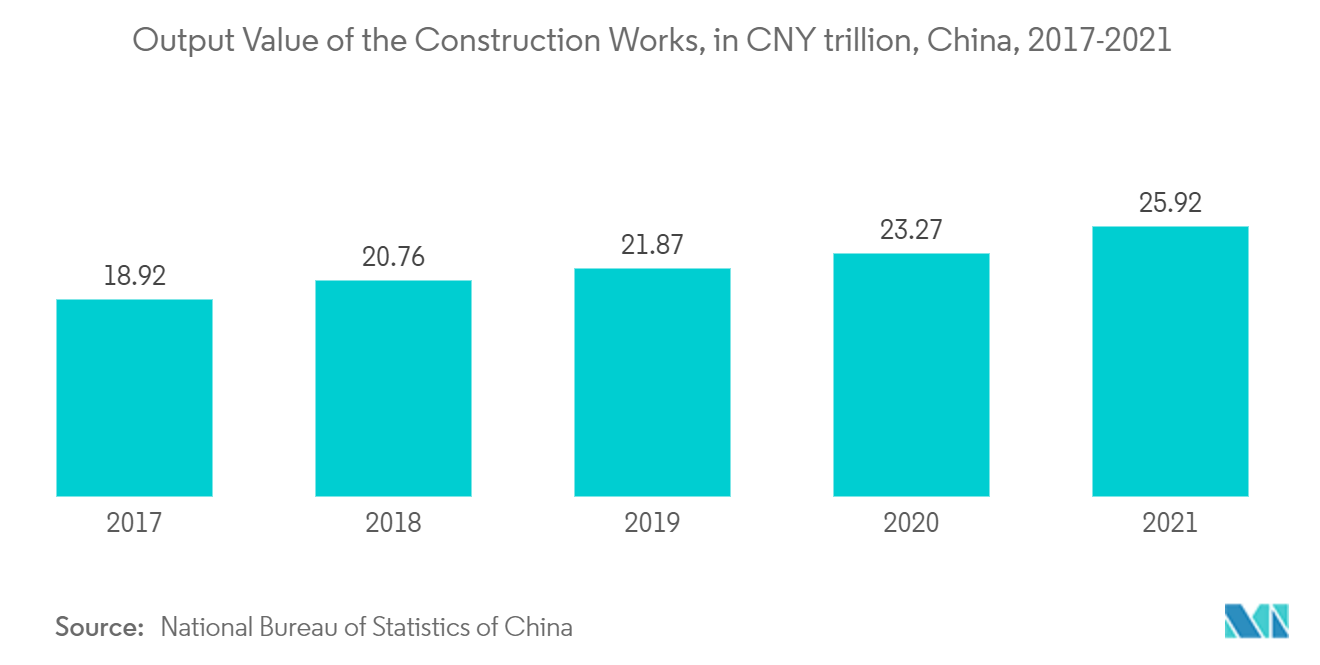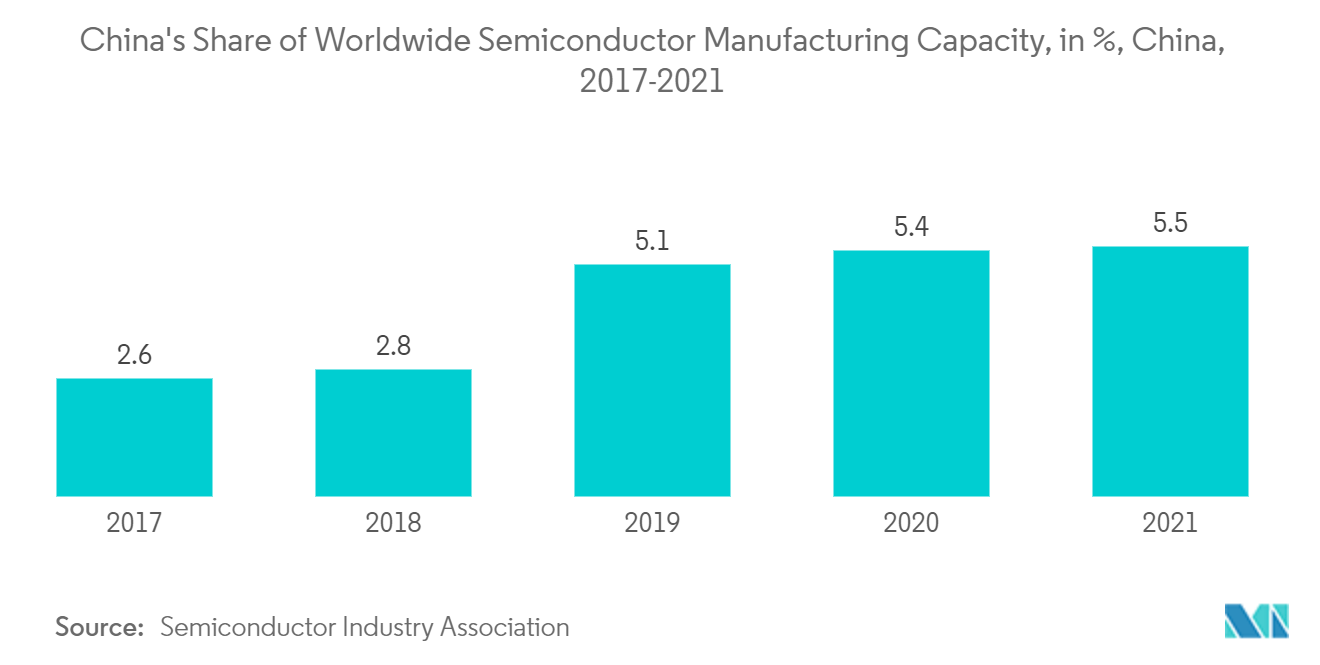Market Trends of Asia-Pacific Colloidal Silica Industry
This section covers the major market trends shaping the APAC Colloidal Silica Market according to our research experts:
Construction Segment to Dominate the Market
- Colloidal silica is commonly used in the construction industry because it increases the strength and durability of concrete or cement. It is also used in floor coatings to make the surface scratch-resistant and to decrease slip by increasing friction.
- Colloidal silica reduces alkalinity, lowering the binder's pH and solubility and thus improving the paint's weather resilience and coatings. In this regard, advancements in paints and coatings further increase the demand in the market.
- Superior features of colloidal silica, such as permeability and pore water reduction, as well as improved rheological properties in concrete, increase its demand in the construction industry. Some of the advantages of employing colloidal silica in concrete include increased cement hydration, resistance to chemical assaults, and quicker cement disintegration.
- The Asia-Pacific construction business has been steadily developing in recent years, owing to rapid urbanization and increasing infrastructure spending in Asian countries. The growing presence of foreign firms in the Asia-Pacific region has also created a demand for the construction of new offices, buildings, manufacturing houses, and so on, which is propelling the growth of the construction sector in the region.
- China accounts for the major share of the construction industry. The Chinese government has announced major development plans associated with the construction industry, including plans to relocate 250 million people to new megacities over the next ten years. As a result, resins in paints and coatings used in various applications during building construction may see a significant increase in demand.
- According to the National Bureau of Statistics of China, the output value of the construction works accounted for CNY 25.92 trillion (USD 25.92 trillion) in 2021 compared to CNY 23.27 trillion (USD 3.34 trillion) in 2020.
- Additionally, the Indian government also places a high priority on infrastructure development to stimulate economic growth. Furthermore, the Indian government committed around INR 64,573 crore (USD 7.937 billion) for the development of new road and bridge infrastructure in 2022-23. Under the Central Vista Project, the government earmarked INR 2,600 crore (USD 319.61 million) for the construction of non-residential office buildings. Furthermore, the real estate industry is projected to grow from USD 1.72 billion in 2019 to USD 9.30 billion in 2040.
- Japan's construction sector is expected to grow at a moderate rate during the next few years, owing to increased expenditures in public and private infrastructure and commercial projects. Japan is a prominent area for skyscrapers and high-rise structures, making it a large consumer market. The country is home to about 290 high-rise buildings, with Tokyo serving as a key hub for such structures. In Japan, the planning and construction of such structures are experiencing moderate growth in the short term, supporting the expansion of the industry.
- In Japan, two high-rise structures for Tokyo Stations, a 37-story and 230-meter-tall office tower and a 61-story and 390-meter-tall office tower, are among the projects scheduled for completion in 2027.
- One of the largest redevelopment projects in Japan is the Yaesu redevelopments project, which will convert old buildings into new offices, hotels, residential, retail, and educational facilities by 2023.
- Other comparable projects include the renovation of Shibaura homes and the construction of new Shimbashi buildings. Further, in 2025, Osaka will host the World Expo, highlighting the country's advancement in the construction sector.
- In 2021, housing projects in redevelopment zones led the growing construction market in northern Taiwan. The region's major municipalities, including Taipei, New Taipei, Taoyuan, Hsinchu, and Keelung, were dominated by housing buildings.
- Furthermore, Taiwan Taoyuan International Airport (TPE), the 11th busiest airport in the world and the largest in Taiwan, is expanding to add Terminal 3. Upon its completion in 2026, the airport will have a capacity of 43 million passengers per year
- All the aforementioned factors are expected to drive the construction segment, which is also likely to impact the demand for colloidal silica during the forecast period.

China is Anticipated to Hold a Major Share of the Asia-Pacific
- China holds a prominent share of the Asia-Pacific Colloidal Silica market in terms of revenue, and its region is set to continue to flourish in its dominance over the forecast period.
- China's expanding construction sector, as well as manufacturing activity in the auto parts, oil, and gas industries, will fuel the paints and coatings demand in the future years. The colloidal silica sector is predicted to benefit from an increase in the use of high-tech coatings such as cationic electrocoating materials that cover all corners of metal parts to provide corrosion protection.
- According to Financial Market Infrastructure (FMI), the East Asian colloidal silica market would account for 30.3% of the overall market share in 2022. Leading colloidal silica manufacturers in China are boosting their investments in the development of this product to meet the needs of end-use applications.
- According to the National Bureau of Statistics of China, China's construction work sector was growing steadily, reaching a total output value of around CNY 25.9 trillion (~USD 3.69 trillion) in 2021. Benefiting from the rapid urbanization, the construction industry in China generated an output of exceeded CNY 29 trillion (~USD 4.15 trillion) in that year.
- Moreover, for Housing developments worth NTD 30 billion (~USD 1.08 billion) in Taiwan and China, the budget includes NTD 10.8 billion (~USD 353.7 million) for Taiwan and NTD 19 million (~USD 0.622 million) for Chengdu, China.
- According to the National Development Council (NDC), the government agencies proposed an NTD 180 billion (~USD 6.47 billion) infrastructure development plan in February 2022, which includes the proposed budget for the fourth stage of the Forward-looking Infrastructure Development Program, which would be used from 2023-2024.
- According to Semiconductor Industry Association, China's Share of Worldwide Semiconductor Manufacturing Capacity was 5.5% in 2021 as compared to 5.4% in 2020.
- Thus, all the above-mentioned factors are likely to increase the growth of the Asia-Pacific colloidal silica market during the forecast period.


